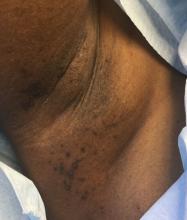Familial benign chronic pemphigus, also known as Hailey-Hailey disease, is an uncommon autosomal dominant genetic condition. A mutation in the calcium ATPase (ATP2C1) gene on chromosome 3q21 interferes with calcium signaling and results in a loss of keratinocyte adhesion. Generally, the onset of the condition is in the second or third decade. There are two clinical subtypes of the disease: segmental type 1 and segmental type 2.
Lesions present as flaccid bullae, vesicles, or erosions that commonly affect the neck, axillae, and flexures. Often there is maceration and fissuring and bullae are no longer intact. Crusting and secondary bacterial, viral, or fungal infection may occur. Lesions can heal with postinflammatory pigmentation but usually do not leave scarring. Heat and sweating may exacerbate the lesions, and they become malodorous. Squamous cell carcinoma has been reported in lesions of Hailey-Hailey, so regular surveillance is important.Histology reveals groups of acantholytic cells that resemble a “dilapidated brick wall.” Direct immunofluorescence is negative, unlike pemphigus vulgaris.
Treatment may be challenging. Topical and systemic corticosteroids often improve lesions. Topical calcineurin inhibitors can be used as steroid sparing agents. Antimicrobial cleansers can be helpful. If secondary infection is present, topical and systemic antibiotics (with Staphylococcus aureus as the most common bacteria involved), antivirals, and antifungals may be added. For extensive disease, cyclosporine and oral retinoids have been used but are not consistent in their efficacy. CO2 laser and surgical grafting can be used for unresponsive disease.As hyperhidrosis is a known aggravating factor, injection with botulinum toxin (this is off-label use not yet approved by the Food and Drug Administration) in affected areas to decrease sweating has been reported to be effective.
This case and photo were submitted by Dr. Bilu Martin.
Dr. Bilu Martin is a board-certified dermatologist in private practice at Premier Dermatology, MD, in Aventura, Fla. More diagnostic cases are available at edermatologynews.com. To submit a case for possible publication, send an email to dermnews@frontlinemedcom.com.



